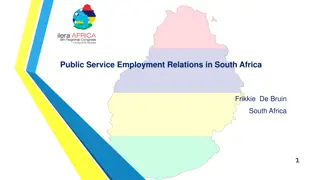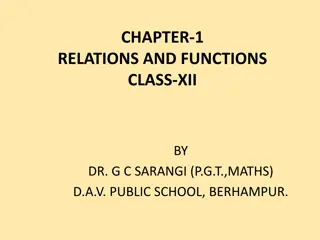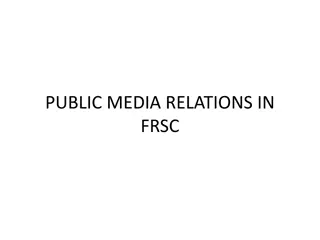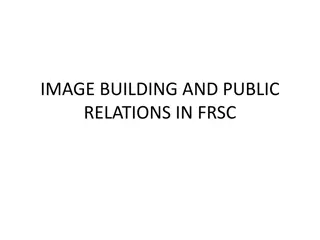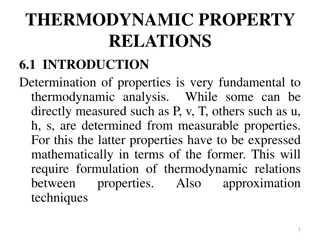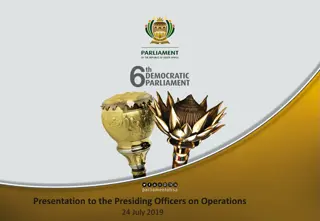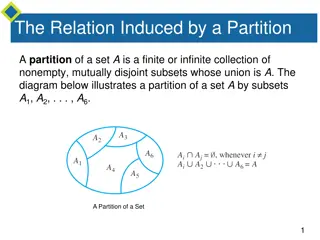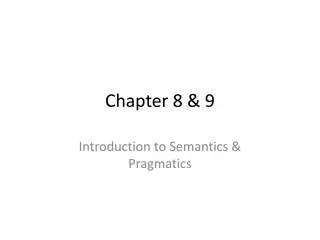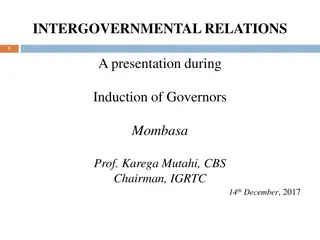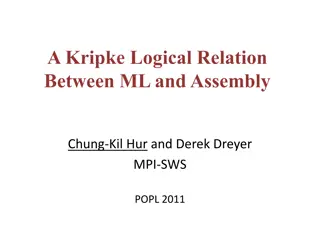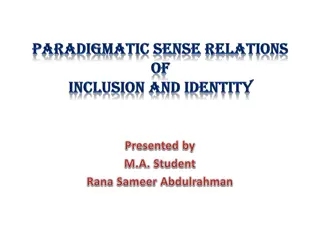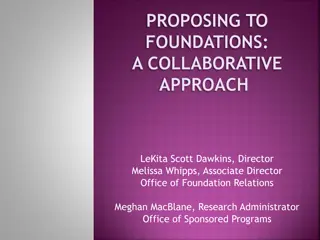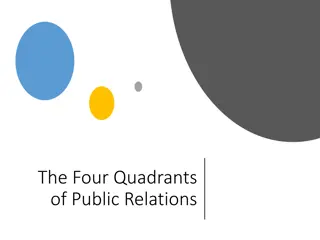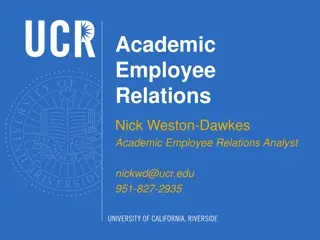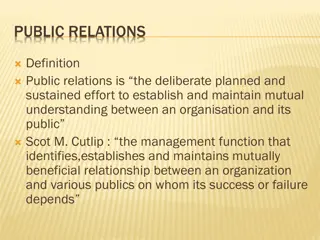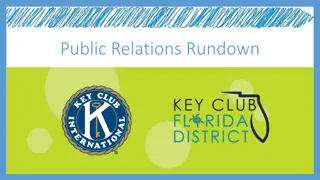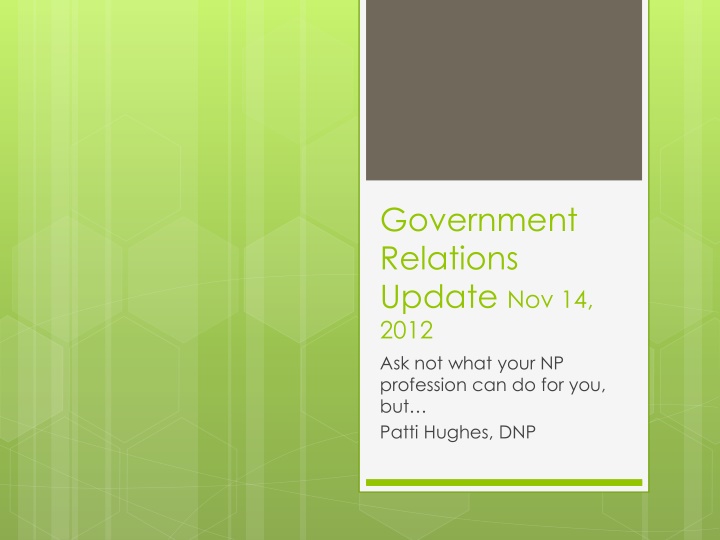
Evolution of Medical and NP Licensing: Government Relations Update
Delve into the historical disparities between medical and NP licensing, explore the evolving regulatory landscape for NPs, and learn about current efforts and legislative initiatives shaping NP practice advancement within the healthcare system.
Download Presentation

Please find below an Image/Link to download the presentation.
The content on the website is provided AS IS for your information and personal use only. It may not be sold, licensed, or shared on other websites without obtaining consent from the author. If you encounter any issues during the download, it is possible that the publisher has removed the file from their server.
You are allowed to download the files provided on this website for personal or commercial use, subject to the condition that they are used lawfully. All files are the property of their respective owners.
The content on the website is provided AS IS for your information and personal use only. It may not be sold, licensed, or shared on other websites without obtaining consent from the author.
E N D
Presentation Transcript
Government Relations Update Nov 14, 2012 Ask not what your NP profession can do for you, but Patti Hughes, DNP
Objectives Describe briefly, differences and history of medical and NP licensing. Describe briefly, the evolution of NP regulatory practice Describe current efforts to address practice and regulatory gaps Describe current legislative initiatives to advance NP practice
Because: our licensure and ability to practice are the core of our Government Relations efforts. Government relations: exists so we may preserve and legally practice according to our abilities. Policy definition: the distribution of resources. We are trying to get a slice of the pie, which means reimbursement from a limited pool.
Graduation from an accredited school and a state license is not enough. What we have can be added to or subtracted by the whim of the legislature, by influence of groups / associations with power, influence or greater resources. This is the purpose of CANP. It is a professional association to represent our professional interests, through its Health Policy committee, chapter legislative representatives, members and PAC fund.
Threats arise daily to our practice through a knowledge deficit of what NPs do, and those who want to curtail our practice (for many reasons, none based on evidence). Stand alone clinics: abortions, public safety, supervision, traditional roles and reimbursement practices. Most common threats are from other professional association groups and of simple omission.
Licensing, and exclusion 1910: no standards for MD education. Flexner Report: standards, 2 yrs of internship required after med school. S/e: Exclusion of women, minorities. Largely segregated professions, professional silos. Medical license granted authority to do anything and everything. US- wide licensure. MDs: Currently a 3- step process with a national competency test and state licensure.
Nursing licensure Prior to Nightingale era, no credentialing or standards. Training programs 6 weeks to 3 years. 1893: Nursing leaders met in Chicago to discuss standards 1896: this group formed precursor organization to ANA. A primary aim: to promote permissive licensure. (graduate from a Nsg school with approved standards)
The situation was so dire in the late 19th century that the first president of the American Nurses Association, Isabel Hampton Robb, lamented that
"In the absence of educational and professional standards, I am sadly forced to admit that the term 'trained nurse' means anything, everything and next to nothing.
RN profession developed standards, licensure. 1947: New York got 1stprofessional licensure, title protection. Florence Nightingale opposed entry licensure: she believed only continuing education could ensure competence. Evolution of nursing roles and knowledge continues.
Graduates of German Nursing school in Chicago.
NP profession Univ of Colorado, 1965. Loretta Ford and Henry Silver. Developed program to meet pediatric prevention and promotion primary care needs. Opposition: from nursing and medical leaders, as it was a departure from traditional nursing roles. Also, no certification process or formal training involved initially.
NP regulation Evolved to require: RN licensure first. Graduation from an accredited NP school. National certification as NP. BUT: Scope of practice and regulations vary state by state. Can be limited by employers or insurance companies. Can be limited by federal regulations. Scope may very within a state.
However, as noted by the Federation of State Medical Boards, even the wide scope of the physician is pressured by "factors including: fluctuations in the health care workforce and specific health care specialties; geographic and economic disparities in access to health care services; economic incentives for physician and non-physician providers, and consumer demand."
Regulations lag practice A historical problem. Expansion and evolution of practice occurs faster than regulations keep up. MDs in CA insisted on Standardized procedures at birth of the NP profession , but now they are too confining. Most professions practice according to their education, competency and licensure. Not piecemeal.
In response CANP provider Project. Attempted to define NP practice through GR, regulations & a separate NP SOP. Cons: piecemeal, expensive, slow. Political opposition by well- financed Physician trade assns. Need to address larger issues: access to care, affordability, quality, teamwork.
Problems with addressing SOP What determines scope? Scope is a minimum standard. If you are the only NP in your state practicing, for example, cardiology, what is the standard? There is the concerning potential for physicians or physician- controlled groups to try to set the standards for your practice.
At best: standards may mandate physician supervision to establish competency. At worst: if lack a specialty certification, credentialing or defined body of knowledge, your standard may be the same as the cardiologist! In 2004 NSO claims data, 6% of all claims were for practicing beyond scope.
Nursing practice is defined and regulated by the Nurse Practice Act of each state. This creates differences and confusion in practice, state by state. Is mandatory collaboration a predictor of safety, as MDs assert? Collaboration does not define the NPs scope. Barbara Saifreit states: it makes no sense to tie a private MD s license to a NPs ability to practice.
IOM Future of Nursing response The IOM, with 18 multi disciplinary, high powered members , recommended Nurses should practice to the full extent of their education and training. Nurses should achieve higher levels of education and training through an improved education system that promotes seamless academic progression.
Nurses should be full partners, with physicians and other health care professionals, in redesigning health care in the United States. Effective workforce planning and policy making require better data collection and an improved information infrastructure.
#1. Remove scope of practice barriers. Recommendations for Congress: Expand Medicare coverage to include APRN services within their state SOP, just as physician services are now covered. Allow APRNs to perform admission assessments, certify for home health services, and admission to hospice and skilled nursing facilities. Equal pay for equal work in primary care for Medicare services Tie federal funding for nursing school programs to only states that have adopted NCSB Nursing Model Practice Act Standards.
For state legislatures: Reform Nursing Practice Acts to conform to NCSB Nursing Model Practice Act and Model Nursing Administrative rules Require 3rdparty payers to reimburse NPs who are practicing within their SOP under state law.
For Center for Medicare, Medicaid Services Amend or clarify the requirements for hospital participation in the Medicare program to ensure that advanced practice registered nurses are eligible for clinical privileges, admitting privileges, and membership on medical staff.
For the Federal Trade Commission and the Antitrust Division of the Department of Justice: Review existing and proposed state regulations concerning advanced practice registered nurses to identify those that have anticompetitive effects without contributing to the health and safety of the public. States with unduly restrictive regulations should be urged to amend them to allow advanced practice registered nurses to provide care to patients in all circumstances in which they are qualified to do so.
From White Paper to action! National level: ACNP, AANP merge to speak with one voice State level: www.caactioncoalition.org State level committee working on recommendations to implement plan. CANP HPPC members active on this committee. Susie Phillips is state co- chair. Along with Ken Tang, of recc 1 task force.
State Recc 1 task force meets q Friday at 2 pm via conf call. They are to compare and contrast NCSBN s model rules with current CA rules and regulations, and to comment on the APRN s perspective on needed changes. They will present this info to the CA BRN in January. BRN has authority to amend current regulations, but they rely on guidance from the profession to ensure change is acceptable to the professions that will be regulated by these changes.
CA Bill review SB 1524 ( Sen Hernandez): Deletes the requirement for NPs have 6 mo of supervised physician clinical experience prior to furnishing license. Approved and signed by Governor. Bill chaptered Sept 29thby Secretary of State. Chapter 796, Statutes o f 2012. Reason: PAs don t have this this requirement. This hindrance gave us a competitive disadvantage.
SB 1338 (Kehoe) Amends state reproductive privacy act (HS Code 123460) to remove barriers that restrict NPs, CNMs, and Pas to perform early abortions using non surgical uterine aspiration technique to improve access to early, safer abortion for CA women. Bill withdrawn at author s request.
SB 623 (Kehoe) Extends the ability to continue with the workforce project to allow NPs/ Pas performing 1sttrimester abortions until the data is published. Approved by governor Chaptered Sept 22 by Secretary of State.
SB 1318 ( Wolk) Involves everyone working at a hospital to get a flu shot or wear a mask during flu season. CANP co- sponsored with CMA. Vetoed by governor. Hospitals can police themselves .
AB 2348 (Assywoman Mitchell) Would allow a RN to dispense hormonal contraceptives pursuant to SPs, if the nurse is functioning within a licensed community clinic. Limited to RNs practicing within this setting. CANP opposed due to restrictions on setting. See IOM report. Approved by Governor Sept 22nd.
Older bills CANP is still following SB 393 (Hernandez) Medical Homes: Establishes the Patient- centered Medical Home Act of 2011 and defines medical home and other terms. Vetoed by governor CANP neutral. Physicians feel strongly that MDs need to lead medical homes.
SB 635, ( Hernandez) Increased funding for primary workforce training. Would increase funding under Song- Brown program, which provides funding for designated NP programs throughout the state. CANP support Carried over from last legislative session.
AB 2266 (Mitchell) Medi-Cal: enhanced health Homes for Frequent Hospital Users with chronic conditions. Establishes a program to provide specified home health services, with the intent of reducing avoidable hospitalizations or use of emergency services. CANP watch Failed passage in committee, Aug 29th
Coming attractions! ACNP National NP health Policy conference, Feb 23-26, 2013 in Wash, D.C. CANP 36thAnnual Edu conference, March 21-24, 2013 , Monterey CA Greater Pasadena Pasadena Flowers for the Float, Dec 8, 2012, at the Rose Bowl
Nurses Float Rose Parade 2013. The president of the 2013 Rose Parade, Sally Bixby RN, is the first nurse to hold this office.
Flowers4thefloat.org CANP of Pasadena Honor Sally Bixby The Greater Pasadena Chapter of the CA Association of Nurse Practitioners will honor Sally Bixby, RN at an event on December 8th from 12 noon- 5 pm at the Brookside Golf Club Mediterranean Ballroom. All colleagues, guests and supporters are invited. See flyer for registration details.
AANP 28thnational Conference, June 19- 23, 2013 at The Venetian and the Palazzo and Sands Expo and Convention Center in Las Vegas. Participation in your State and National NP Organization protects your ability to practice.

